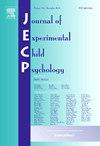Spatial associations of number and pitch in human newborns
IF 1.8
2区 心理学
Q3 PSYCHOLOGY, DEVELOPMENTAL
引用次数: 0
Abstract
Humans use space to think, reason about, externally represent, and even talk about many dimensions (e.g., time, pitch height). One dimension that appears to exploit spatial resources is the mental representation of the numerosity of a set in the form of a mental number line. Although the horizontal number–space mapping is present from birth (small–left vs. large–right), it is unknown whether it extends to other spatial axes from birth or whether it is later acquired through development/experience. Moreover, newborns map changes in pitch height onto a vertical axis (low pitch–bottom vs. high pitch–top), but it is an open question whether it extends to other spatial axes. We presented newborns (N = 64 total, n = 16 per experiment, 0–4 days) with an auditory increase/decrease in magnitude along with a visual figure on a vertically oriented screen (bottom vs. top, change in number: Experiments 1 and 2; change in pitch: Experiment 3) or on a horizontally oriented screen (left vs. right, change in pitch: Experiment 4). Newborns associated changes in magnitude with a vertical axis only when experiencing an increase in magnitude (increase/up); however, the possibility that visuospatial biases could account for this asymmetric pattern are discussed. Newborns did not map changes in pitch horizontally (Experiment 4), in line with previous work showing that the horizontal mapping of number at birth does not generalize to other dimensions. These findings suggest that the flexible use of different spatial axes to map magnitude is not functional at birth and that the horizontal mapping of number might be privileged.
新生儿数字和音高的空间关联
人类利用空间来思考、推理、外部表征,甚至谈论多个维度(如时间、音高)。似乎利用空间资源的一个维度是以心理数轴的形式对一个集合的数量进行心理表征。虽然水平数字空间映射从出生开始就存在(小左vs大右),但不知道它是否从出生开始扩展到其他空间轴,还是后来通过发展/经验获得。此外,新生儿将音调高度的变化映射到垂直轴上(低音调底部vs高音调顶部),但它是否扩展到其他空间轴是一个悬而未决的问题。我们向新生儿(N = 64,每个实验N = 16, 0-4天)展示听力增加/减少的幅度,以及垂直方向屏幕上的视觉图像(底部与顶部,数量变化:实验1和2;音调变化:实验3)或在水平方向的屏幕上(左vs右,音调变化:实验4)。新生儿只有在经历幅度增加(增加/上升)时才会将幅度变化与垂直轴联系起来;然而,讨论了视觉空间偏差可能解释这种不对称模式的可能性。新生儿不会水平映射音高的变化(实验4),这与之前的研究一致,表明出生时数字的水平映射不能推广到其他维度。这些发现表明,在出生时,灵活地使用不同的空间轴来绘制大小是不可能的,而数字的水平映射可能是优先的。
本文章由计算机程序翻译,如有差异,请以英文原文为准。
求助全文
约1分钟内获得全文
求助全文
来源期刊

Journal of Experimental Child Psychology
Multiple-
CiteScore
4.50
自引率
7.70%
发文量
190
期刊介绍:
The Journal of Experimental Child Psychology is an excellent source of information concerning all aspects of the development of children. It includes empirical psychological research on cognitive, social/emotional, and physical development. In addition, the journal periodically publishes Special Topic issues.
 求助内容:
求助内容: 应助结果提醒方式:
应助结果提醒方式:


